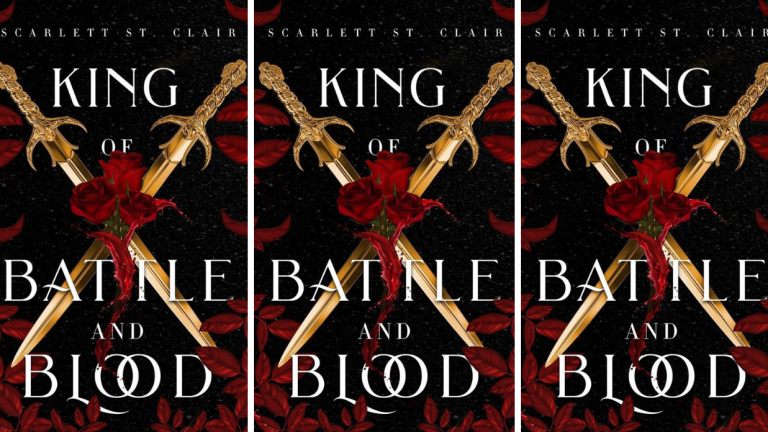King of Battle and Blood: A Dark Vampire Fantasy For a Female Gaze
We talked to author Scarlett St. Clair about not having to choose between dark fantasy and romance in King of Battle and Blood.

In the world of fiction, vampire stories tend to take one of two paths. In some versions, these undead creatures are purely monstrous, the sort of vicious predators we’d all do well to fear. (Author Jay Kristoff’s epic fantasy Empire of the Vampire is perhaps the most recent—and excellent—example of this trend.) But if the massive success of the Twilight franchise has taught us anything, it’s that our pop culture loves the idea of vampires as love interests. And, to be honest, there’s something to be said for the whole broody, eternally handsome Goth boy thing, complete with killer cheekbones and a capacity to love that is as potentially deadly as it is swoon-worthy. But, nine times out of ten, those stories tend to stay in their own lanes, and never the twain shall meet. Usually.
Scarlett St. Clair’s new novel, King of Battle and Blood, is a vampire tale that tries to straddle both of these worlds at once, mixing all the myth-making and bloody conflict of epic fantasy with the entertaining sexiness of a dark and dangerous romance. The result is something that feels surprisingly fresh: Fantasy aimed squarely and unashamedly at female readers, and stories that are as concerned with slow-burn romance and steamy sex as they are building a larger internal mythology.
“[Fantasy] is such a male-dominated genre traditionally,” St. Clair “But I don’t think there’s anything wrong with combining those two genres. I love fantasy and I love romance. Why would I not want to write something with both?”
King of Battle and Blood primarily centers on Princess Isolde of Lara, who must marry vampire Adrian Aleksandr Vasile, known as the Blood King, in order to end a years-long war and prevent her people from being slaughtered by his slowly advancing army. A reluctant bride, Isolde initially plans to assassinate her new husband at the first opportunity, but as the pair grow closer, she discovers many of her preconceptions about Adrian and his people are very wrong.
Although the crux of the story revolves around Isolde’s personal emotional growth (and her shifting sexual relationship with the man she’s been forced to marry), the novel has plenty of high fantasy elements. There’s a continent-spanning war, a mysterious mist that seems to kill anyone it touches, renegade witches, and a complex polythestic belief system that may or may not involve reincarnation. And that’s all before you even get to the promise of an even darker turn for our heroine in the novel’s inevitable sequel, in which it seems that she’ll turn her back on many of the things she once valued.
Far too many fantasy series tend to treat women as supporting figures: Love interests, damsels to be rescued, victims of violence, or passive figures who must spend their lives reacting to the action happening around them. But St. Clair had a very particular vision for the sort of heroine she wanted King of Battle and Blood’s Isolde to be—and it wasn’t any of those things.
“I see Isolde as a true morally gray character,” she says. “But you have to take it in the context of her world, like what she’s willing to do to survive. Where’s the balance? What lines are you willing to cross?”
Because the heart of Isolde’s story is, like so many fantasy heroes before her, about figuring out who she truly is—and what sort of woman she wants to become.
“She discovers everything she had built her belief system on is wrong. And I think we all go through that,” she continues. “I grew up in a small town and I had the beliefs of my parents so ingrained into me…and when I went to college, and I was like, yeah, everything they told me is a lie. You spend all this time trying to undo or figure out what you believe. It’s a tale as old as time, honestly.”
A big part of Isolde’s emotional journey is also irrevocably connected to her love of pleasure, her understanding of what she needs from a relationship in a physical sense, and, eventually, her increasingly messy feelings for the man she marries.
“I wanted to write a woman who was comfortable with sex. [Who was] comfortable with setting boundaries with men,” St. Clair says. “So often we slut shame women for wanting casual sex or [for] seek[ing] out pleasure. And I think that’s wrong because we don’t shame men for doing it! In a society where we often disempower women through sex, I think we need to see a woman like [Isolde].”
King of Battle and Blood features multiple explicit sexual scenes, but none of the encounters feel exploitive or are solely meant to titillate. Instead, the steamier moments feel as though they’re pieces of a much larger whole.
“People look at sex scenes and think it’s just a sex scene, but what it does is it illustrates the changing relationship that’s taking place,” St. Clair says.
For her as a writer, centering Isolde’s perspective and grounding the story in the changes her character is going through was always paramount. And, in a way, the book’s steamier interludes are just another kind of worldbuilding.
“I think that you have to really be very mindful about how you use sex in your plot. It’s part of the character arc of this person. And Isolde went from just kind of exploring and having fun and whatever to being with one person. And she maybe teases him at first but she learns through all of this what kind of relationship she actually wants to have.”
St. Clair goes on to describe several spoiler-y scenes from different points in Aidan and Isolde’s relationship and how their changing reactions toward and treatment of one another illustrate the changing depth of their connection. “It’s just another tool. it’s a plot-building device. It’s a relationship-building device. Not enough people sort of look at sex scenes that way,” she says.
King of Battle and Blood is St. Clair’s first novel with a traditional publisher: Bloom Books, an imprint of Sourcebooks that touts entrepreneurial female authors and purports to “redefine what it means to have a happily ever after”. She self-published the first installment of her popular Hades X Persephone series in 2019.
“When I was very popular as a self-published author, I was looking for an agent or a publisher and I was told that people who loved fantasy would not understand the romance and people who loved romance would not understand the fantasy,” she says. “And I just [knew] they were wrong.”
In fact, according to her, the Hades X Persephone readers couldn’t get enough of fantasy mixed with more overtly romantic elements.
“My readers were so eager for this kind of world meshing. I feel like there’s this tendency in traditional publishing to not recognize what readers actually want. And [as a result,] they’re more than two years behind on everything that they’re putting out. So I think in a couple of years you might see more of this sort of fantasy romance stuff.”
To be fair, there are several big-name female authors writing successful high fantasy stories that include significant romantic elements these days, such as Sarah J. Mass’ Crescent City books or Jennifer L. Armentrout’s From Blood and Ash series. But both those women initially found success in other genres, specifically young adult fiction and traditional romance.
“I was told you can’t write [fantasy romance] until you prove yourself in YA because this kind of thing does really well in YA,” St. Clair explains. “That’s what they were saying: You have to prove yourself like Maas did. You’ll have to write YA first and then go into the adult market. I was like, wait a minute. You’re telling me that I’ve been writing for adults in this vein for over a year now. And I’ve made a ton of money and I still have to prove myself?”
Romance is a wildly successful genre, yet is often treated like the dirty little secret of the publishing world, frequently sneered at by overly elitist literary types and purposefully left off more traditionally mainstream bestseller lists
“Romance makes billions of dollars!” St. Clair laughs. “It’s like you have all the science here, all the numbers that you should be dominating the markets with romance and you don’t do it because people think it’s ‘not literary’ or whatever.”
This sort of stigma attached to the romance genre is not new, whether those stories are set in fantasy worlds or in contemporary America. But St. Clair insists that the assumptions involved are way off base.
“Romance can be literary and a romance plot can be literary. [People say] that romance doesn’t have a plot, right? No! Romance has a plot,” she says. “A plot is just actions. Romance just has a different set of actions. It’s the actions you take falling in love.”
And according to St. Clair, romance fills a very specific need for many readers. One that she’s more than happy to help meet.
“I think, ultimately, people want to know that people fall in love At the heart of our culture, we love happy endings and we love romance,” St. Clair says. “But somehow it’s the butt of every joke. And I’m just like, well you can have that opinion and I will laugh all the way to the bank.”
